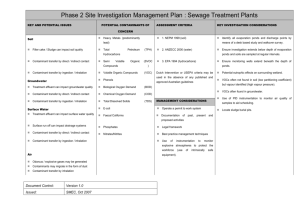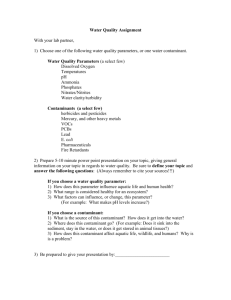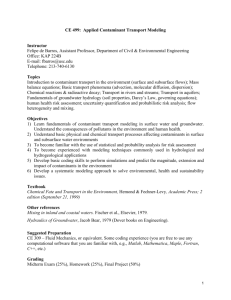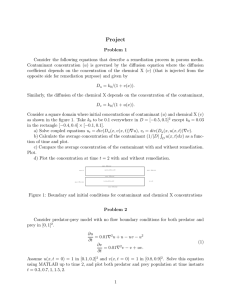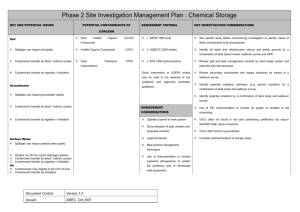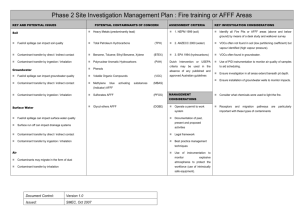SECTION I ESTABLISHMENT OF AN AREA OF REGULATED GROUNDWATER USAGE (A)
advertisement
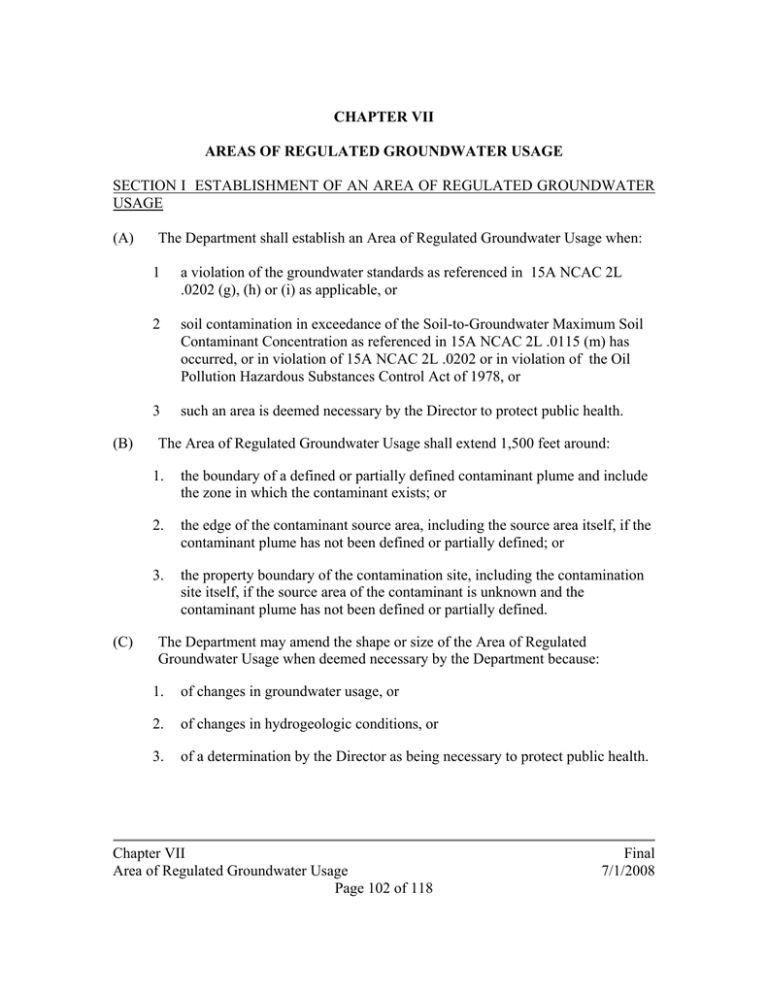
CHAPTER VII AREAS OF REGULATED GROUNDWATER USAGE SECTION I ESTABLISHMENT OF AN AREA OF REGULATED GROUNDWATER USAGE (A) (B) (C) The Department shall establish an Area of Regulated Groundwater Usage when: 1 a violation of the groundwater standards as referenced in 15A NCAC 2L .0202 (g), (h) or (i) as applicable, or 2 soil contamination in exceedance of the Soil-to-Groundwater Maximum Soil Contaminant Concentration as referenced in 15A NCAC 2L .0115 (m) has occurred, or in violation of 15A NCAC 2L .0202 or in violation of the Oil Pollution Hazardous Substances Control Act of 1978, or 3 such an area is deemed necessary by the Director to protect public health. The Area of Regulated Groundwater Usage shall extend 1,500 feet around: 1. the boundary of a defined or partially defined contaminant plume and include the zone in which the contaminant exists; or 2. the edge of the contaminant source area, including the source area itself, if the contaminant plume has not been defined or partially defined; or 3. the property boundary of the contamination site, including the contamination site itself, if the source area of the contaminant is unknown and the contaminant plume has not been defined or partially defined. The Department may amend the shape or size of the Area of Regulated Groundwater Usage when deemed necessary by the Department because: 1. of changes in groundwater usage, or 2. of changes in hydrogeologic conditions, or 3. of a determination by the Director as being necessary to protect public health. Chapter VII Area of Regulated Groundwater Usage Page 102 of 118 Final 7/1/2008 (D) The Department shall maintain public records identifying parcels subject to the restrictions imposed by areas of regulated groundwater usage. The Department shall make these records available to the public. SECTION II REPEAL OF AN AREA OF REGULATED GROUNDWATER USAGE (A) When, to the satisfaction of the Department, it has been demonstrated that a contamination site and the groundwater quality has been restored to its natural state, the Area of Restricted Groundwater Usage may be repealed by the Department. SECTION III REQUIREMENTS FOR NEW WATER SUPPLY WELLS WITHIN AN AREA OF REGULATED GROUNDWATER USAGE (A) If a public water supply (exclusive of Transient and Non Transient water supply wells) is available, then: 1. a new well will not be permitted 1,000 feet or less from: a. the boundary of a defined or partially defined contaminant plume; or b. the edge of the contaminant source area, if the contaminant plume has not been defined or partially defined; or c. the property boundary of the contamination site, if the source area of the contaminant is unknown and the contaminant plume has not been defined or partially defined 2. a new well may be permitted at distances greater than 1,000 feet and up to and including 1,500 feet from: a. the boundary of a defined or partially defined contaminant plume; or b. the edge of the contaminant source area, if the contaminant plume has not been defined or partially defined; or c. the property boundary of the contamination site, if the source area of the contaminant is unknown and the contaminant plume has not been defined or partially defined 3. a well permitted within the zone defined in Section IV (A) 2 of this Chapter will require: Chapter VII Area of Regulated Groundwater Usage Page 103 of 118 Final 7/1/2008 a. compliance with well construction standards in Chapter II of these Regulations b. grouting the full extent of the casing c. an initial water sample following well completion per the provisions in Chapter II Section VI Sampling. In addition the water sample must be analyzed for the contaminant(s)-of-concern. A Certified Laboratory must perform the analysis. The analysis must be submitted to the Department for review and approval prior to the well being placed in service. d. biannual sampling (every two years) and analysis for the contaminant(s)of-concern. A Certified Laboratory must perform the analysis. The analysis must be submitted to the Department within 24 hours if any contaminant is detected. All reports of sample analysis shall be kept by the well Owner for at least six years and provided to the Department upon request. Or the Owner may submit all analytical reports. Sampling is the responsibility of the Owner of the well. 4. the Department may waive or modify sampling requirements on a well by well basis if: a. it can be demonstrated that a non-impacted well of similar dimensions to the subject well exist between the contamination plume and the new well, or b. a hydrogeologic review of the Area of Regulated Groundwater Usage, conducted by a North Carolina Professional Engineer or Licensed Geologist and presented to the Department, indicates that the well is not at risk of being impacted by the contamination plume. The Department must concur with the findings of the review before modification to the sampling schedule may be granted. 5. a new well determined to contain a contaminant must be treated to remove the contaminant(s)-of-concern, such that the water would be considered potable, for as long as the well is active and the raw water contains the contaminant(s)of-concern. A notice of Groundwater Contamination must be notarized and recorded with the Register of Deeds prior to the Department issuing a Certificate of Completion and the well being placed in service. 6. treated water must be sampled according to manufacturer’s specifications to insure the treatment system is functioning as designed. The period of sampling shall be sufficient to insure against contaminant breakthrough. Chapter VII Area of Regulated Groundwater Usage Page 104 of 118 Final 7/1/2008 7. the water sample must be analyzed for the contaminant(s)-of-concern. A laboratory certified by the State must perform the analysis. Sample results must be submitted to the Department for review. 8. treatment is the responsibility of the responsible party except under the following condition: a. the contaminant(s) identified in the water sample taken from the subject well is not associated with the contaminant released by the Responsible Party. 9. in instances where a contaminant(s) detected in a water sample is not associated with the contaminant released by the responsible party or where no responsible party has been identified, the well Owner is responsible for water treatment. 10. a well which contains contaminant(s), but is not active must be permanently abandoned per provisions of Chapter II Section VIII paragraph B (7) of these Regulations. (B) If a public water supply is not available, then: 1. a new well may be permitted inside the Area of Regulated Groundwater Usage so long as the well is located outside the defined or partially defined contaminant plume and the well location meets all other site and setback requirements listed in Chapter II of these Regulations. 2. a new well constructed within an Area of Regulated Groundwater Usage will require: a. compliance with the well construction standards in Chapter II of these Regulations b. grouting the full extent of the casing c. an initial water sample following well completion per the provisions in Chapter II Section VI Sampling. In addition the water sample must be analyzed for the contaminant(s)-of-concern. A laboratory certified by the State must perform the analysis. The analysis must be submitted to the Department for review and approval prior to the well being placed in service. d. biannual sampling (every two years) and analysis for the contaminant(s)of-concern. A laboratory certified by the State must perform the analysis. Chapter VII Area of Regulated Groundwater Usage Page 105 of 118 Final 7/1/2008 The analysis must be submitted to the Department within twenty-four hours if any contaminant is detected. All reports of sample analysis shall be kept by the responsible party for at least six years and provided to the Department upon request. Biannual sampling is the responsibility of the contamination plumes responsible party. 3. the Department may waive or modify periodic sampling requirements on a well by well basis if: a. it can be demonstrated that a non-impacted well of similar dimensions to the subject well exist between the contamination plume and the subject well, or b. a hydrogeologic review of the Area of Regulated Groundwater Usage, conducted by a North Carolina Professional Engineer or Licensed Geologist and presented to the Department, indicates that the well is not at risk of being impacted by the contaminant plume. The Department must concur with the findings of the review before modification to the sampling schedule may be granted. 4. if the contamination site in question is an orphan site with the State or federal government acting in place of the responsible party, or if no responsible party has been assigned then periodic sampling may be completed by the Department if funding is available. Otherwise, periodic sampling and analysis becomes the responsibility of the well Owner. A laboratory certified by the State must perform the analysis. The analysis must be submitted to the Department for review. 5. water from a new well that is determined to contain a contaminant(s) must be treated to remove the contaminant(s)-of-concern, such that the water would be considered potable, for as long as the well is active and the raw water contains the contaminant(s)-of-concern. A notice of Groundwater Contamination must be notarized and recorded with the Register of Deeds prior to the Department issuing a Certificate of Completion and the well being placed in service. 6. treated water must be sampled according to manufacturer’s specifications to insure the treatment system is functioning as designed. The period of sampling shall be sufficient to insure against contaminant breakthrough. 7. the water sample must be analyzed for the contaminant(s)-of-concern. A laboratory certified by the State must perform the analysis. Sample results must be submitted to the Department for review. Chapter VII Area of Regulated Groundwater Usage Page 106 of 118 Final 7/1/2008 8. treatment is the responsibility of the responsible party except under the following condition: a. the contaminant(s) identified in the water sample taken from the subject well is not associated with the contaminant released by the Responsible Party. 9. in instances where a contaminant(s) detected in a water sample is not associated with the contaminant released by the responsible party or where no responsible party has been identified, the well Owner is responsible for water treatment. 10. a well which contains contaminant(s), but is not active must be permanently abandoned per provisions of Chapter II Section VIII paragraph B (7) of these regulations. SECTION IV REQUIREMENTS FOR EXISTING WATER SUPPLY WELLS WITHIN AN AREA OF REGULATED GROUNDWATER USAGE. (A) An existing water supply well located within an Area of Regulated Groundwater Usage will require: 1. an initial water sample following identification of the contaminant. The water sample must be analyzed for the contaminant(s)-of-concern. A laboratory certified by the State must perform the analysis. The analysis must be submitted to the Department for review. 2. biannual sampling (every two years) and analysis for the contaminant(s)-ofconcern. A laboratory certified by the State must perform the analysis. The analysis must be submitted to the Department for review. Biannual sampling is the responsibility of the contaminant plumes responsible party. 3. the Department may waive or modify sampling requirements on a well by well basis if: a. it can demonstrated that a non-impacted well of similar dimensions to the subject well exist between the contaminant plume and the subject well, or b. a hydrogeologic review of the Area of Regulated Groundwater Usage, conducted by a North Carolina Professional Engineer or a North Carolina Licensed Geologist and presented to the Department, indicates that the well is not at risk of being impacted by the contaminant plume. The Chapter VII Area of Regulated Groundwater Usage Page 107 of 118 Final 7/1/2008 Department must concur with the findings of the review before modification to the sampling schedule may be granted. 4. if the contamination site in question is an orphan site with the State or federal government acting in place of the responsible party, or if no responsible party has been assigned then periodic sampling may be completed by the Department if funding is available. Otherwise, sampling and analysis becomes the responsibility of the well Owner. The water sample must be analyzed for the contaminant(s)-of-concern. A laboratory certified by the State must perform the analysis. The analysis must be submitted to the Department for review. 5. water from an existing water supply well that is determined to contain a contaminant(s) must be treated to remove the contaminant(s)-of-concern, such that the water would be considered potable, for as long as the well is active and the raw water contains the contaminant(s)-of-concern. A notice of Groundwater Contamination must be notarized and recorded with the register of Deeds. 6. treated water must be sampled according to manufacturer’s specifications to insure the treatment system is functioning as designed. The period of sampling shall be sufficient to insure against contaminant breakthrough. 7. the water sample must be analyzed for the contaminant(s)-of-concern. A laboratory certified by the State must perform the analysis. Sample results must be submitted to the Department for review. 8. treatment is the responsibility of the responsible party except under the following condition: a. the contaminant(s) identified in the water sample taken from the subject well is not associated with the contaminant released by the Responsible Party. 9. in instances where a contaminant(s) detected in a water sample is not associated with the contaminant released by the responsible party or no responsible party has been identified the well Owner is responsible for water treatment. 10. a well which contains a contaminant(s) but is not active must be permanently abandoned per provisions of Chapter II Section VIII paragraph B (7). Chapter VII Area of Regulated Groundwater Usage Page 108 of 118 Final 7/1/2008
